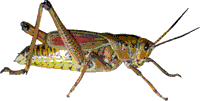Entomology Collections, General

Entomology Papers from Other Sources
Document Type
Article
Date of this Version
1988
Abstract
Four types of sensilla are present on the antennal surface of four tropical tephritid species of economic importance-the Mexican fruit fly, Anastrepha ludens (Loew); the Mediterranean fruit fly, Ceratitis capitata (Wiedemann); the melon fly, Dacus cucurbitae Coquillett; and the oriental fruit fly, D. dorsalis Hendel. Three types of porous sensilla occur only on the funiculus. Two types of multi porous pitted sensilla (MPS)-thick-walled and thin-walled-house dendritic branches, and both are probably chemoreceptors. Electrophysiological recordings from cells associated with a thick-walled MPS in C. capitata showed that it responds to trimedlure, a known attractant. Multiporous grooved sensilla also occurring on the funiculus were, however, too small for recordings. No-pore sensilla are found only on the scape and pedicel, and electrophysiological recordings show them to be mechanoreceptors.


Comments
Published in Ann. Entomol. Soc. Am. 81(2): 325-331 (1988).